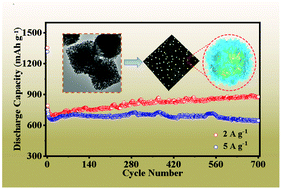Polyoxometalate@MOF derived porous carbon-supported MoO2/MoS2 octahedra boosting high-rate lithium storage†
Abstract
Structural stability and rapid charge–discharge capability of electrode materials are required for high performance lithium-ion batteries (LIBs). The materials derived from polyoxometalates (POMs) show special advantages in inhibiting capacity attenuation, and good dispersion or combination of POMs with metal–organic frameworks (MOFs) is an important method to obtain high activity anode composites for LIBs. In this study, a uniform MoO2/MoS2 heterostructure with surface supported carbon (C-MoO2/MoS2) was successfully fabricated from a [Cu2(BTC)4/3(H2O)2]6[H3PMo12O40] precursor, which showed not only the designed octahedral morphology but also fast charge transfer, long working life, and high rate performance. Superior reversible lithium storage capacity of 1047 mA h g−1 after 300 cycles was obtained at 1 A g−1. Even after 700 cycles at 5 A g−1, the discharge specific capacity of 646 mA h g−1 was maintained, and rate capability of 610 mA h g−1 could be achieved at 10 A g−1. The high capacitive contribution could be explained by the relatively large specific surface area of porous C-MoO2/MoS2, which was mainly caused by the supported carbon network and MoS2 nanosheets, resulting in fast lithiation/delithiation processes.



 Please wait while we load your content...
Please wait while we load your content...